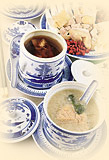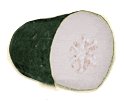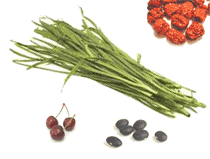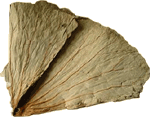I. Chinese Food Therapy for Weight Loss
Chinese people are very concerned about their daily food consumption; they consider it a first line of treatment. It is common for the Chinese to treat a minor ailment with a specially prepared meal or by including a particular ingredient in a dish. Based on the classification of patterns suggested above, there are two main ways of treating obesity by food therapy:
|

Chinese people consider food a first line treatment of obesity |
| |
|
|
A. Methods of drying the body
- Urination
- Absorb dampness inside the body
- Cool the body to facilitate fluid passage
- Warm the body
|
| |
1. Promote urination
 |
| Wax gourd promotes urination. |
The first method is to promote urination, which may be compared with diuretics in Western medicine. Small red beans, corn and corn silk, Job's tears, soya beans, wax gourd and garlic significantly promote urination.
2. Get rid of water in the Body
This method involves absorbing tissue fluids in the body. Absorbing water in the body can be compared to that of a sponge soaking up spilt water; promoting urination removes water from the body through excretion. The majority of foods and herbs that can absorb water inside the body are aromatic, and the two items used most frequently are broad beans and hyacinth beans. The aromatic foods not only can absorb water inside the body, but also can stop diarrhea for the same reason.
 |
 |
| oad beans help absorb water inside the body. |
Broad beans can be ground into a powder to be taken with warm water, but they can also be fried with oil and salt until they break and smell aromatic. Use unshelled beans, as the shell has a better effect of absorbing water inside the body and promoting urination. |
 |
Hyacinth beans can be used the same as broad beans. In Chinese herbal therapy, hyacinth beans are very frequently used to relieve diarrhea and abdominal pain due to excessive water in the intestine. They may be used in soup or in powder form. |
3. Cool the body to facilitate passage of water
A dry-hot physical constitution is not prone to obesity as is a damp-hot physical constitution. For example, if you set fire to damp firewood, it will not burn quickly but produce a lot of smoke, which is not good. Similarly when water and heat mix in the body, neither will go away. The result is difficulty when urinating or discharge of reddish urine in small quantities.
The strategy, therefore, is to cool the body, allowing water to flow. Food and herbs with a cold energy and a bitter flavor are used for this purpose, because cold energy can cool the body and the bitter flavor can dry it.
 |
 |
| Bitter gourd and mung beans are helpful in people with a hot damp physical constitution. |
Bitter gourd - can significantly cool the body, reduce nervous tension due to its cold energy, and also can soften the stools due to its bitter flavor. People with a hot-damp physical constitution often suffer from constipation, which may be effectively relieved by using bitter gourd as a soup, as a vegetable or as a tea. |
 |
Mung beans. May be used by those with a hot-damp physical constitution to rid the body of excessive water. Although mung beans have a cool energy and a sweet flavor, they are rather effective in removing water and reducing body heat. |
4. Warm the body
This is suitable for people with a cold-damp physical constitution. The strategy is to warm the body so that the water can flow out of the body, either through urination or perspiration. Foods producing best results should have a warm or hot energy and a pungent-sweet flavor. Hot or warm energy increases body heat, pungent flavor increases perspiration, and a sweet or light flavor promotes urination. Cinnamon satisfies these three conditions.
 |
Cinnamon |
 |
Fresh ginger - is used frequently to counteract cold, particularly in winter and when it is used along with dry orange peel to make tea, its effects are significantly reinforced. |
**After the excessive evils in the body have been removed and the body is dry, the person should remain slim and stay in good shape. However, a balanced diet and regular exercise should always be maintained. |
| |
Top |
| B. How can the body stop retaining water?
An overweight person has two enemies in the body: phlegm and dampness. One important thing is to get rid of those enemies and the other is to keep them out of the body. A useful concept to keep in mind is the concept of fire ?o. Fire gets rid of dampness and phlegm by burning them. So fire is used in the treatment, particularly with the kidney's fire, which refers to kidney-yang.
|
| |
Increase the Burning Fire of the Kidneys
Increasing the burning fire of the kidneys will help in the maintenance of correct body weight.
Foods called yang tonics can increase the burning fire of the kidneys. In TCM, there are four basic tonics: energy tonics, blood tonics, yin tonics (strengthens the fluids) and yang tonics. (A tonic is something that strengthens.)
| |
 |
Animals' kidneys are highly recommended yang tonics. Eating kidneys (pork, beef, lamb or chicken) have 3 advantages:
| - |
They have little fat |
| - |
They are easily digested |
| - |
They tone up the kidney's function |
Preparing kidneys to eat
First cut the kidneys in half, remove the unwanted white parts and wash it; bring water to the boil and add a little wine; drop in the kidneys and simmer until fully cooked; drain and slice into small pieces. Prepare a sauce with ginger, green onion, green pepper, soy sauce, sugar, sesame oil and vinegar. Pour the sauce over the kidneys and they are ready to eat.
|
| |
 |
Liver (Chicken, pork and beef) is the second food recommended as a yang tonic to increase the burning fire of the kidneys. Fry the liver very quickly in vegetable oil with condiments such as ginger, garlic, or celery; use black pepper and wine as seasonings.
|
| |
 |
Fruits and vegetables such as dried green raspberry, cherry, yam, walnut, leeks, black beans and bitter gourd seed may also be used as yang tonics. |
 |
| Fruits and vegetables that benefit the kidney yang: red dates cherry, garlic chives and black beans. |
|
| |
Top |
|
C. Functional Food Recipes
Here are some recipes that ventilate and smooth the lungs and resolve phlegm, invigorate the spleen, remove dampness through diuresis (urination) warm the kidneys in order to relieve water retention.
|
| |
1. Fried Crown daisy Chrysanthemum and Radish
Therapeutic benefit: Removing fluid stagnation and clearing away phlegm-heat
Method: Wash 200g of white radish, 100g of crown daisy chrysanthemum, and cut into strips. Pour 100g of oil into a pot. When the oil is hot, add wild pepper. When the wild pepper turns black, remove it, and then add the radish strips. Add a little chicken soup until almost tender; then add the crown daisy chrysanthemum. Add salt to taste, mix in starch when the dish is done and pour a little sesame oil over it. Remove from heat and serve.
2. Fried Mutton with Wild pepper and Onions
Therapeutic benefit: Warming kidney-yang
Method: Pour 50g of peanut oil into a pot, and heat over a flame. Add a little wild pepper, 200g mutton shreds, 10g ginger shreds, 100g onions, and fry. Add salt, seasoning powder, vinegar and yellow wine to taste.
3. Weight Reducing Wine
Therapeutic benefit: Tonifying the spleen and expelling dampness
Method: Prepare and wash 1000g polished glutinous rice, 150g Job's tears, 50g lotus seeds powder, 100g Chinese yam powder, 50g Gordon Euryale seed (qian shi), 50g Indian bread. Mix well and put into a large vessel and add some water. Steam for one hour, cool and soak with baking wine until all the ingredients are covered and then seal the cover properly. Place the vessel in a warm place (25° Centigrade) for 36 - 48 hours. Each time take one small cup, twice daily.
4. Soup of Lotus Leaf and Hawthorn
Therapeutic benefit: Promoting digestion and expelling dampness
 |
| Dried lotus leaf |
Methods: Take lotus leaf 9g and hawthorn 9g (hawthorn should be broken up and stir-fried), 2 cups of water, decoct into 1 cup of soup. For simple obesity, it is suitable to drink frequently. |
|